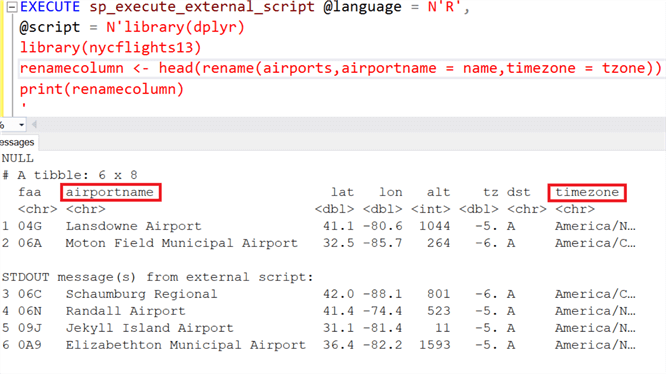

For example, if we want to have capital letters as a factor level but the original data has small letters of English alphabets.

The basic syntax for doing so is as follows: data > rename (newname1 oldname1, newname2 oldname2. Please share the tutorial on your social media accounts if you did.We know that a factor variable has many levels but it might be possible that the factor levels we have are not in the form as needed. Another way to rename columns in R is by using the rename () function in the dplyr package. It has a simple syntax where it is necessary to pass the new. Second, we had a look at the recode_factor() function from the dplyr package to do the same. The rename() function of dplyr package can be used to change the column names of a data frame.
Dplyr rename how to#
First, we had a look at how to use the levels() function to recode the levels of factors. In this tutorial, you have learned how to rename factor levels in R. MUSIC In this lesson, I want to introduce you to four very useful functions from the dplyr package for pre-processing data, the Mutate function for creating. For instance, another package that is part of the Tidyverse package has a function that can be used: forcats. We can use the renameat command from dplyr package, which allows you to select columns using the column selection methods and to use text wrangling functions. Note that there are other ways to recode levels of a factor in R.

startswith ('Person') : Df1 > renameat (vars (startswith ('Person')), 'ID') Df1 > renameat (1, 'ID') Both give: ID Phone.1 Phone.2 Animals 881717 NA Cat 2 148. This can be, of course, also be done with other packages that are part of the TIdyverse. These two options work, though seems very fragile to rename in this way It only works if you have exactly one column that meets the condition, i.e. Deprecating the functions count and rename in the plyr package seems simpler. If you forget this, and the input is a data frame with a single column, the output will be a vector, not a data frame. One of the primary things that slows me down in R is data management. It can also be used to add a column to an R data frame based other columns, or to simply add a column to a data frame in R. For fully seamless transition between plyr and dplyr, a compatibility package looks like a possible option.It would provide the union of the exported functions of both packages, and compatibility wrappers for the two functions count and rename that need special attention. dplyr::arrange () orders the rows of a data frame by the values of one or more columns: The desc () helper allows you to order selected variables in descending order: Note the use of drop FALSE. Using dplyr and pipes to rename variables 2 minute read R. One of the best solutions to this problem is using the name of the package (namespace) with necessary function like this dplyr::select. When dplyr and MASS are loaded, then select is used with MASS. Each following argument is then the other factors we want to be renamed.Īs previously mentioned, dplyr is a very useful package. You can check that out by writing the function in the console. This argument is then followed by the level of a factor (e.g., the first) and then the new name. As you can see, the antijoin functions keeps only rows that are non-existent in the. The output has the following properties: Rows are not affected. ) Arguments Value An object of the same type as. The recode_factor() function works in a way that the first argument is the character vector. Description rename () changes the names of individual variables using newname oldname syntax renamewith () renames columns using a function. On the second line, we assign the renamed factors to the column containing our categorical variable. This can be handy if you want to join two dataframes on a key, and its easier to just.
Dplyr rename code#
In the code example above, we first loaded dplyr so that we get the recode_factor() function into our name space. With dplyr, its super easy to rename columns within your dataframe. It returns an updated object of the same type as. Incongruent = "InCon") Code language: R ( r ) : This is an additional argument, used to rename variables names as newnameoldname. Data$TrialType <- recode_factor(data$TrialType, congruent = "Con",


 0 kommentar(er)
0 kommentar(er)
